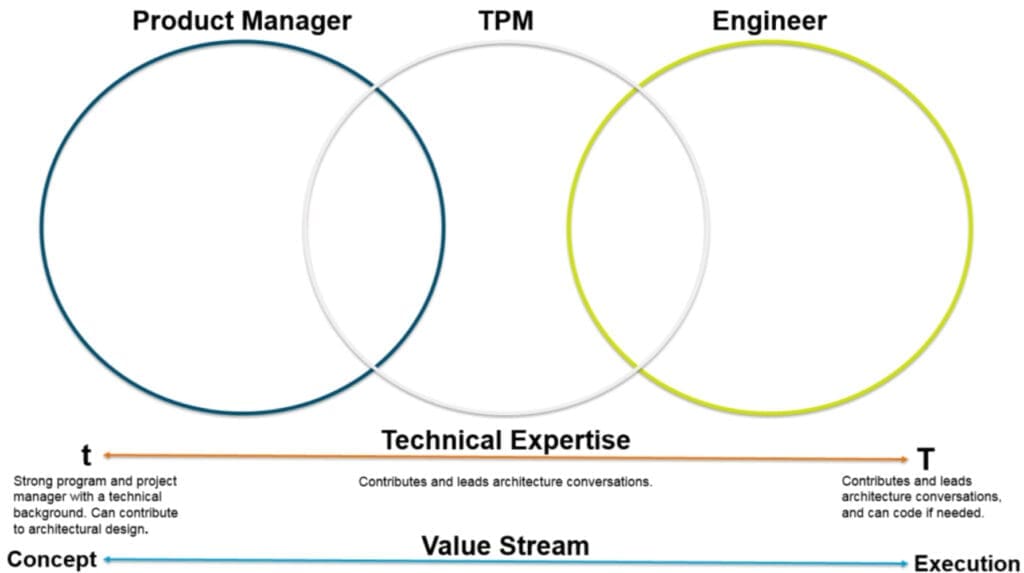
Understanding the nuances of different delivery roles is critical when assessing what sort of expertise your organization has and/or needs.
This can get rather complicated when responsibilities overlap and role definitions differ across departments and companies.
For instance, expectations can get rather complex when comparing program, project, and product management roles, like a technical program manager (TPM) vs a product manager or technical product manager.
Technical Program Manager vs Product Managers:
First, let’s break down the general traits and responsibilities of product managers and technical program managers.
Product Managers: Responsibilities & Traits
- Business focused
- Strong project and program management skills
- Helps create the vision for products
- Manages product-related business financials and planning
- Drives feature prioritization
- Manages customer feedback loops, as well as customer experience trials and events.
- May have product owners under them who are responsible for engineering work-streams. For example, a product manager could be responsible for the next generation Xbox, while the product owners would focus on smaller components like Xbox Live, the controller, networking, etc.
- Note – Technical product managers or technical product owners fulfill a similar role as listed above but for highly technical products.
Technical Program Managers: Responsibilities & Traits
- Focused on engineering execution, planning, and design
- Usually a former software engineer
- Often works closely with developers
- May be more aligned to the business side of the value stream depending on how technically savvy the TPM is and what the delivery need is.
- In charge of handling all delivery aspects of one or more technical projects for their organization
- Typically work with technical companies that have adopted SOA (service-oriented architecture) and microservices architecture technologies.
- Responsible for driving programs, following progress, and providing support in case issues arise
- Will often drive technical dependencies that have to make changes for their project(s) to launch
- Often work the full life-cycle of projects from idea generation through deployment and optimize the full release value stream
- Can help establish the technologies, tools, and processes that can move an organization towards Continuous Integration and Deployment and a DevOps operating model.
- Often involved in non-functional aspects of software delivery such as application telemetry, performance, reliability, resilience, security, and compliance.
Product Manager vs Technical Program Manager Roles, Venn Diagram:
To help visualize the difference between the roles in product delivery, let’s evaluate the diagram below.

As you can see, each role occupies different points within the value stream – the steps a product idea takes to progress through an organization from ideation, or concept, through product development, and technical execution.
Value Stream: Product Managers vs Technical Program Managers
Product managers tend to be much closer to the conceptual and business side of the value stream, whereas TPMs are generally working more closely with engineers and the execution end of the value stream.
This coincides with their level of technical expertise, since TPMs will be more involved in architecture conversations and may even code if the organization needs it.
Technical Depth Required: Product Managers vs Technical Program Managers
Another layer to consider is the technical depth required to move a product through the value stream. We like to think about this in terms of a little ‘t’ in TPM meaning less technical experience and a big ‘T’ TPM meaning they bring a lot of technical experience. This range allows for some overlap between the roles above.
For example, if the technical program manager has less technical expertise and is more of a tPM they will likely work more closely with the business side of product development and management.
If they are stronger technically, they may be less focused on the product or business side and get heavily involved in engineering. A good way to envision this is by sliding the technical program manager’s circle in the diagram to the left or right based off their engineering aptitude.
Ultimately, any overlap in responsibilities depends on what the organization needs. This is why AIM Consulting’s Delivery Leadership practice emphasizes having a range of TPMs with moderate to deep technical expertise to fit different client needs.
Need Project Delivery Assistance?
We are technology consulting experts & subject-matter thought leaders from leading organizations who have come together to form a consulting community that delivers unparalleled value to our client partners.




